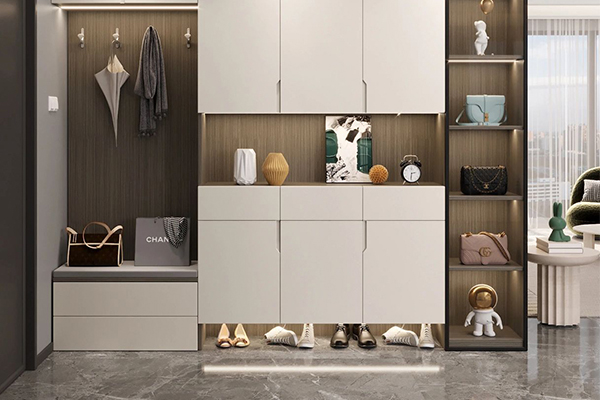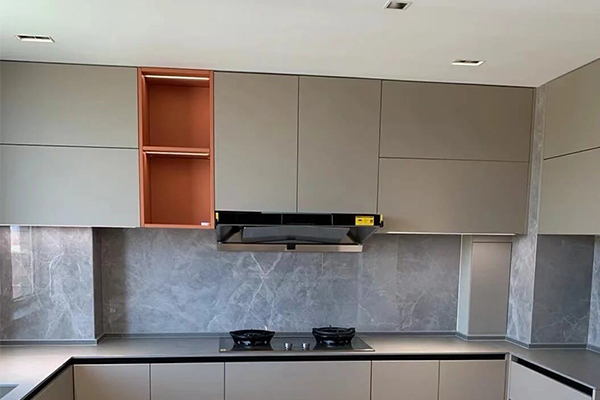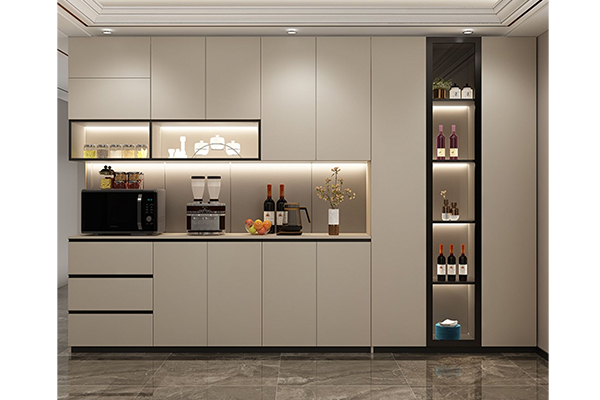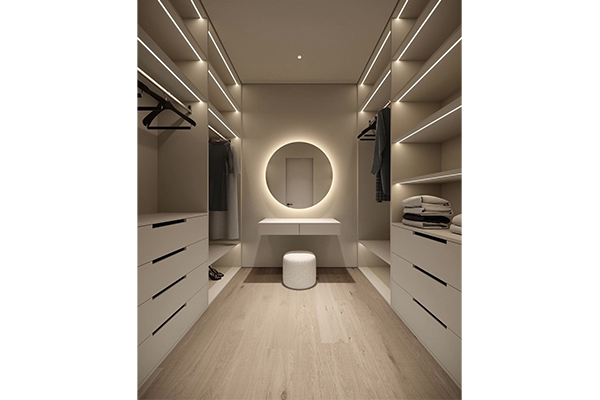How can shoe cabinets improve convenience for family members through zoning?
Release Time : 2025-09-15
In modern families, shoe cabinets have long transcended simple storage functions, evolving into a "transportation hub" within the entryway and a concentrated reflection of family members' lifestyles. With the diversification of family structures and the increasing variety of shoes, the traditional "one cabinet, all in one" model is no longer sufficient. Through scientific zoning, shoe cabinets not only achieve efficient storage but also significantly improve convenience for each family member, optimizing daily circulation and creating a neat and organized home environment.
1. Zoning by Family Member: Personalized Storage, Enhanced Sense of Community
A typical family often includes adults, children, and the elderly, each with varying shoe sizes, quantities, frequency of use, and habits. By implementing "personal zoning" within a shoe cabinet, each family member can be allocated a dedicated space, eliminating the confusion and difficulty of finding shoes and other items. For children, design low, open compartments or pull-out shoe baskets to facilitate independent access and foster self-care skills from an early age. For adults, design mid- and high-rise enclosed compartments to store formal footwear like commuter shoes and high heels, keeping them neat and presentable. For the elderly, designate spacious, easily accessible areas for comfortable, non-slip slippers or walking shoes, minimizing bending and enhancing safety. This personalized partitioning not only improves efficiency but also fosters a sense of belonging and respect for the shared space for each family member.
2. Partitioning by Function: Clear Classification for More Efficient Use
Partitioning shoe cabinets also involves functional divisions. Modern households carry a wide variety of footwear, including outdoor shoes, athletic shoes, slippers, sandals, boots, and dress shoes. Each type of footwear requires a different storage method and environment. Functional partitioning allows for dedicated shoe storage, enhancing convenience. Designate a ventilated area for moisture-prone athletic shoes, equipped with breathable mesh or dehumidification modules. Create a closed-door area for seasonal footwear (such as winter snow boots and summer sandals) that's rarely worn, keeping it dust- and moisture-proof. Design drawers to store small items like insoles, shoelaces, and care tools to reduce clutter. Even create a "seasonal shoe area" or "visitor shoe area" to flexibly accommodate different needs. Clear functional zoning allows family members to quickly locate the shoes they need, reducing searching time and improving efficiency.
3. Zoning by frequency of use: Optimizing circulation and convenient access
Zoning management should also consider the frequency of shoe use. Highly used shoes (such as commuting shoes and slippers) should be placed in an easily accessible location, typically in the middle or bottom of the shoe cabinet. Low-frequency shoes (such as holiday dress shoes and travel boots) can be placed at the top or further back. This "high-frequency close, low-frequency far" layout principle is ergonomic, reduces bending or tiptoeing, and is particularly user-friendly for the elderly and children. Furthermore, shoe cabinets often feature a suspended area at the bottom for storing shoes worn that day, allowing for easy removal and clutter at the door. Some high-end shoe cabinets also feature rotating or sliding rails to push shoes directly to the front, greatly enhancing accessibility.
4. Expanding to Family Scenario: Balancing Intelligence and Sharing
With the development of smart homes, zoning management has also incorporated technological elements. For example, smart shoe cabinets can use facial recognition or mobile apps to identify users and automatically open corresponding zones or remind them to change shoes. For families with pets, a "pet shoe area" can be set up to specifically store pet rain boots or nursing shoes, demonstrating personalized care. Zoning also promotes sharing and collaboration among family members. For example, a "family shared area" can be set up to store slippers, rain boots, or cleaning shoes for easy centralized management and access. Clear labeling or color coded separations prevent confusion and foster good household storage habits.
Zoning in a shoe cabinet may appear to be a simple division of space, but it actually reflects a deep understanding and respect for the family's rhythm of life, family members' needs, and behavioral habits. Through scientific partition design, the shoe cabinet has transformed from a passive storage device into an intelligent assistant that enhances the quality of life. It not only makes shoe retrieval more convenient and storage more organized, but also invisibly promotes harmony and mutual understanding among family members.
1. Zoning by Family Member: Personalized Storage, Enhanced Sense of Community
A typical family often includes adults, children, and the elderly, each with varying shoe sizes, quantities, frequency of use, and habits. By implementing "personal zoning" within a shoe cabinet, each family member can be allocated a dedicated space, eliminating the confusion and difficulty of finding shoes and other items. For children, design low, open compartments or pull-out shoe baskets to facilitate independent access and foster self-care skills from an early age. For adults, design mid- and high-rise enclosed compartments to store formal footwear like commuter shoes and high heels, keeping them neat and presentable. For the elderly, designate spacious, easily accessible areas for comfortable, non-slip slippers or walking shoes, minimizing bending and enhancing safety. This personalized partitioning not only improves efficiency but also fosters a sense of belonging and respect for the shared space for each family member.
2. Partitioning by Function: Clear Classification for More Efficient Use
Partitioning shoe cabinets also involves functional divisions. Modern households carry a wide variety of footwear, including outdoor shoes, athletic shoes, slippers, sandals, boots, and dress shoes. Each type of footwear requires a different storage method and environment. Functional partitioning allows for dedicated shoe storage, enhancing convenience. Designate a ventilated area for moisture-prone athletic shoes, equipped with breathable mesh or dehumidification modules. Create a closed-door area for seasonal footwear (such as winter snow boots and summer sandals) that's rarely worn, keeping it dust- and moisture-proof. Design drawers to store small items like insoles, shoelaces, and care tools to reduce clutter. Even create a "seasonal shoe area" or "visitor shoe area" to flexibly accommodate different needs. Clear functional zoning allows family members to quickly locate the shoes they need, reducing searching time and improving efficiency.
3. Zoning by frequency of use: Optimizing circulation and convenient access
Zoning management should also consider the frequency of shoe use. Highly used shoes (such as commuting shoes and slippers) should be placed in an easily accessible location, typically in the middle or bottom of the shoe cabinet. Low-frequency shoes (such as holiday dress shoes and travel boots) can be placed at the top or further back. This "high-frequency close, low-frequency far" layout principle is ergonomic, reduces bending or tiptoeing, and is particularly user-friendly for the elderly and children. Furthermore, shoe cabinets often feature a suspended area at the bottom for storing shoes worn that day, allowing for easy removal and clutter at the door. Some high-end shoe cabinets also feature rotating or sliding rails to push shoes directly to the front, greatly enhancing accessibility.
4. Expanding to Family Scenario: Balancing Intelligence and Sharing
With the development of smart homes, zoning management has also incorporated technological elements. For example, smart shoe cabinets can use facial recognition or mobile apps to identify users and automatically open corresponding zones or remind them to change shoes. For families with pets, a "pet shoe area" can be set up to specifically store pet rain boots or nursing shoes, demonstrating personalized care. Zoning also promotes sharing and collaboration among family members. For example, a "family shared area" can be set up to store slippers, rain boots, or cleaning shoes for easy centralized management and access. Clear labeling or color coded separations prevent confusion and foster good household storage habits.
Zoning in a shoe cabinet may appear to be a simple division of space, but it actually reflects a deep understanding and respect for the family's rhythm of life, family members' needs, and behavioral habits. Through scientific partition design, the shoe cabinet has transformed from a passive storage device into an intelligent assistant that enhances the quality of life. It not only makes shoe retrieval more convenient and storage more organized, but also invisibly promotes harmony and mutual understanding among family members.







